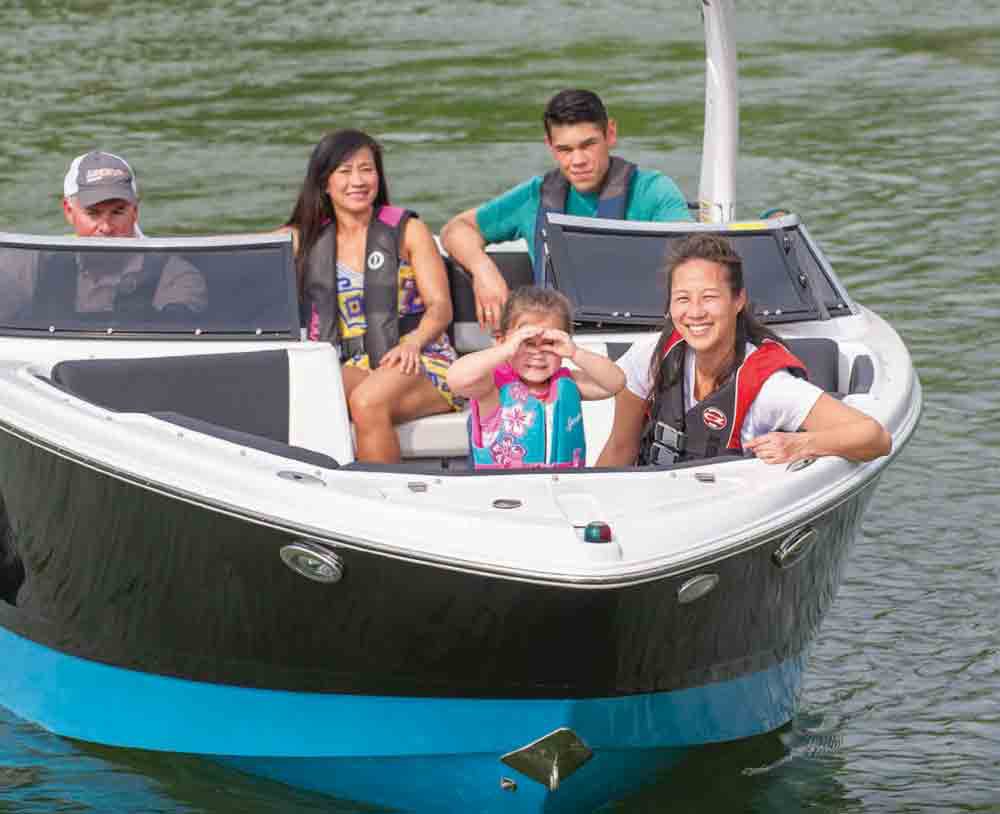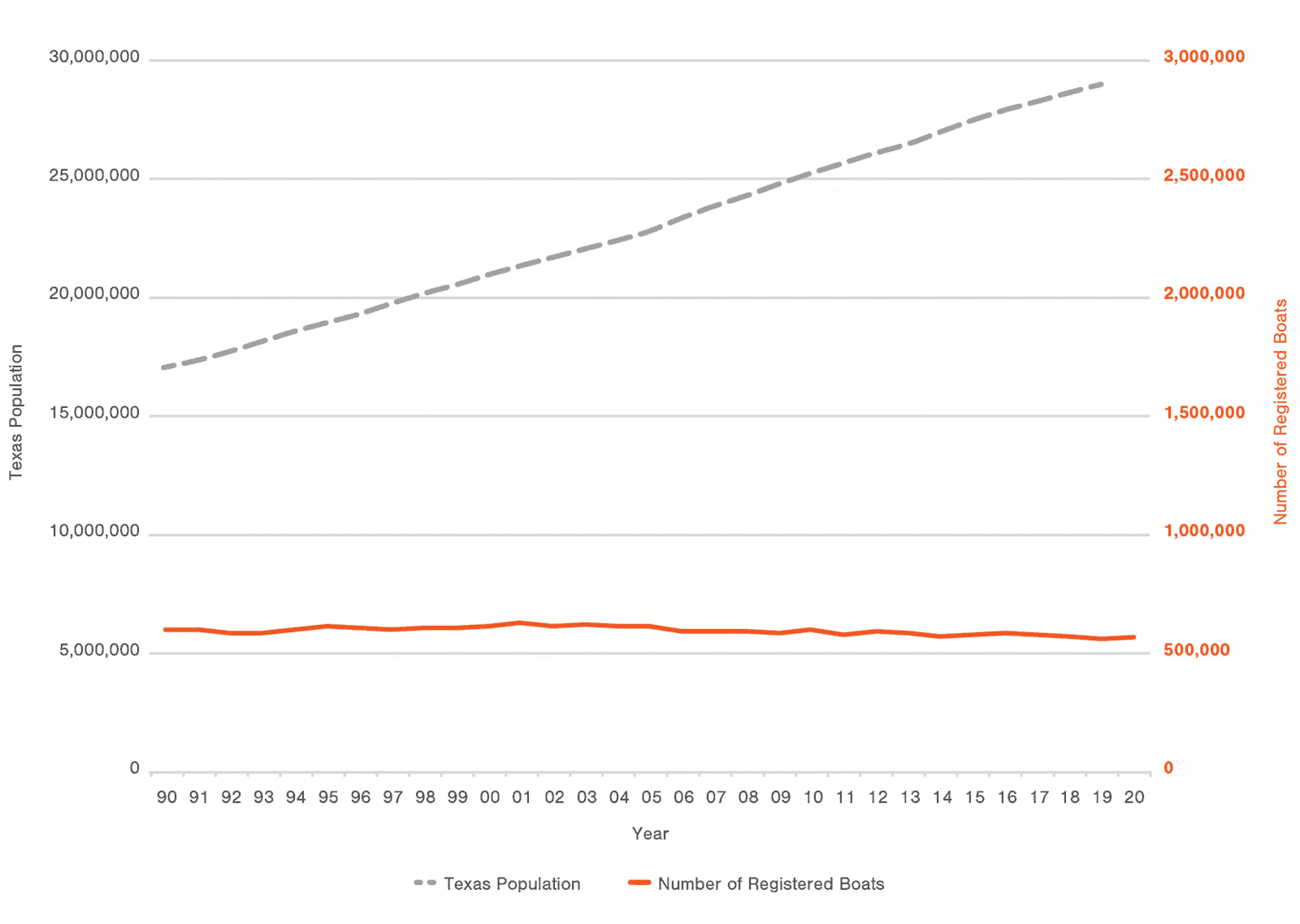Texas R3 Boating Goals
Table of Contents
Skip to Goals
- Increase number of recreational boating participants in Texas
- Increase the number of registered recreational boats in Texas
- Establish customer relationship with the paddling community
Each year, 4.5 million people participate in one or more boating activities in Texas (U.S. Coast Guard, 2012). As a state, Texas has over 1,700 recreational boating related businesses which support nearly 26,000 jobs and contribute to an annual economic impact of $7.7 billion (Marine Manufacturers Association, 2018). Texas also has close to 580,000 registered power and sail recreational boats (J. Aronow, personal communication), however, the rapidly increasing Texas population is far out-pacing growth in boat registrations. See Figure 3. TPWD needs to increase efforts to engage more Texans in boating.

“The Boat Registration Reactivation Program is entirely funded by RBFF, requiring nothing more than state agency staff time to carry out. Throughout the life of the program, nearly $14 million in registration fees has been generated from 382,482 boats being re-registered. Response rate for the 2019 program was 10.25%, a 1.5% increase over 2018 and well above the direct
mail benchmark of 3%.”
— RBFF Press Release, November 2019
The boat registration numbers in Figure 3 do not include paddlers (canoes, kayaks, paddleboards, etc.). Currently, paddlecraft do not have to be registered in Texas, and there are estimated to be over 290,000 paddlecraft in the state. According to a 2019 Special Report on Paddlesports, 22.9 million or 7.6% of the U.S. population participates in paddling activities each year (Outdoor Foundation, 2019). Texas’ portion of that might be as high as 623,000 new paddlers. With access to 1.7 million acres of reservoirs, 4 million acres of saltwater, and 190,000 miles of rivers and streams, it’s no wonder that boating is the fastest growing outdoor recreational sport in Texas. In addition, there is considerable crossover with anglers. This is best illustrated by the fact that kayak fishing has quickly become one of the fastest growing outdoor activities in Texas.
This large group of outdoor recreational users is an under-engaged resource for TPWD. They represent potential crossover constituents to other activities and long-term supporters of our conservation efforts. The department must develop a plan to communicate with this group and incorporate the paddling community into our R3 efforts.
Figure 3: Texas boat registration sales compared to Texas population, 1990-2020.

Note: In 2020, boating registrations increased by 5,014 over previous year. A large part of this increase can be attributed to the COVID-19 pandemic, which has given people more time and inclination to social distance and relieve stress by getting outside. With so many other activity options being limited, or unavailable, people have turned to hunting, fishing, boating, parks and other outdoor activities.
Outline of Boating Goals
- Goal 1: Increase the number of recreational boating participants in Texas
- Objective: Increase boating access
Metric: Implementation of plan
Target Audience: All boaters
Timeframe: Short-term- Catalog current information resources to establish a baseline of boating access information
- Identify physical facilities – boat ramps, paddling trails, shoreline access, leased public access, and private access
- Identify programs – livery (rental, lease), R3 (TPWD and partners), skills training
- Use spatial technologies (GIS software, census data and other demographic databases) to focus access opportunities near target groups
- Expand the number of river miles available for boating through leased public river access areas and/or Texas paddling trails
- Provide opportunities, resources and social support, both online and physical (for first-time boat owners and boaters with a lapsed registration), to connect with the boating community
- Create an internal agency boating committee
- Stand up a cross-divisional group representing all boating-related programs that will collaborate and coordinate efforts to recruit, retain and reactivate boaters and educate them to recreate on the water safely
- Collaborate and coordinate all boating programs and activities
- Catalog current information resources to establish a baseline of boating access information
- Objective: Communicate boating access information to boaters and potential boaters
Metric: Should be established after action 1.2.1 below is completed
Target Audience: Major metro boaters, GenX and GenY
Timeframe: Short-term
- Develop a communication plan of cataloged information resources
- List physical facilities – boat ramps, paddling trails, shoreline access, leased public access, and private access
- List programs – livery, R3 (TPWD and Partner), skills training
- Update and maintain agency web pages (fishing and boating sections) with current public access information
- Increase the number of recruitment activities for new boaters
- Incorporate R3 strategies into all boater recruiting activities
- Increase the number of rental activities at federal, state and local community partner access points
- Develop a communication plan of cataloged information resources
- Objective: Increase boating access
- Goal 2: Increase the number of registered boats in Texas
- Objective: Maintain 9% per year registration renewal lift among lapsed boat owners
Metric: Boat registrations
Target Audience: Boat owners with lapsed registration
Timeframe: Short-term- 2.1.1 Continue using the RBFF direct mail license renewal program to reach boat owners with lapsed registration
- 2.1.2 Increase email reminders to boat owners with lapsed vessel registration, targeting those boaters whose vessel registration has expired within the past two years
- Objective: Identify boat registration churn rate and develop a comprehensive plan to address the churn rate
Metric: Identification of the boat registration churn rate
Target Audience: Existing boat owners
Timeframe: Short-term - Engage the IT department to construct a mechanism to identify boat registration churn rate and new boat purchases on a monthly basis
- Increase proportion of existing boat registrants for whom TPWD has email addresses
- Enhance/expand the current proactive email marketing campaign to maintain boat registrations
- Develop and implement a text messaging program to maintain existing boaters
- Objective: Maintain 9% per year registration renewal lift among lapsed boat owners
- Objective: Establish a paddlecraft user group
Metric: User group is established
Target Audience: Paddling community members, Texas Paddling Trail partners
Timeframe: Short-term
- Develop user group
- Develop a list of potential members (individuals and organizations)
- Select and recruit members
- Conduct first meeting and develop a plan to keep them engaged
Metric: Subcommittee meeting and best practices identified
Target Audience: Paddlers
Timeframe: Short-term
- Create an internal agency paddling subcommittee as part of the boating committee identified in action item 1.1.5
- Identify the community of paddlers using Cross-Program Goal 2
- Research the recreational and educational desires of these target audiences
- Identify the best practices to reduce paddling-related fatalities, conserve resources and reduce user conflict
- Communicate findings with partners and paddlecraft users
- Implement best practices internally
Texas boasts 78 official Paddling Trails across the state, providing improved fishing and paddling access to rivers, creeks, lakes, ponds, bayous and bays.